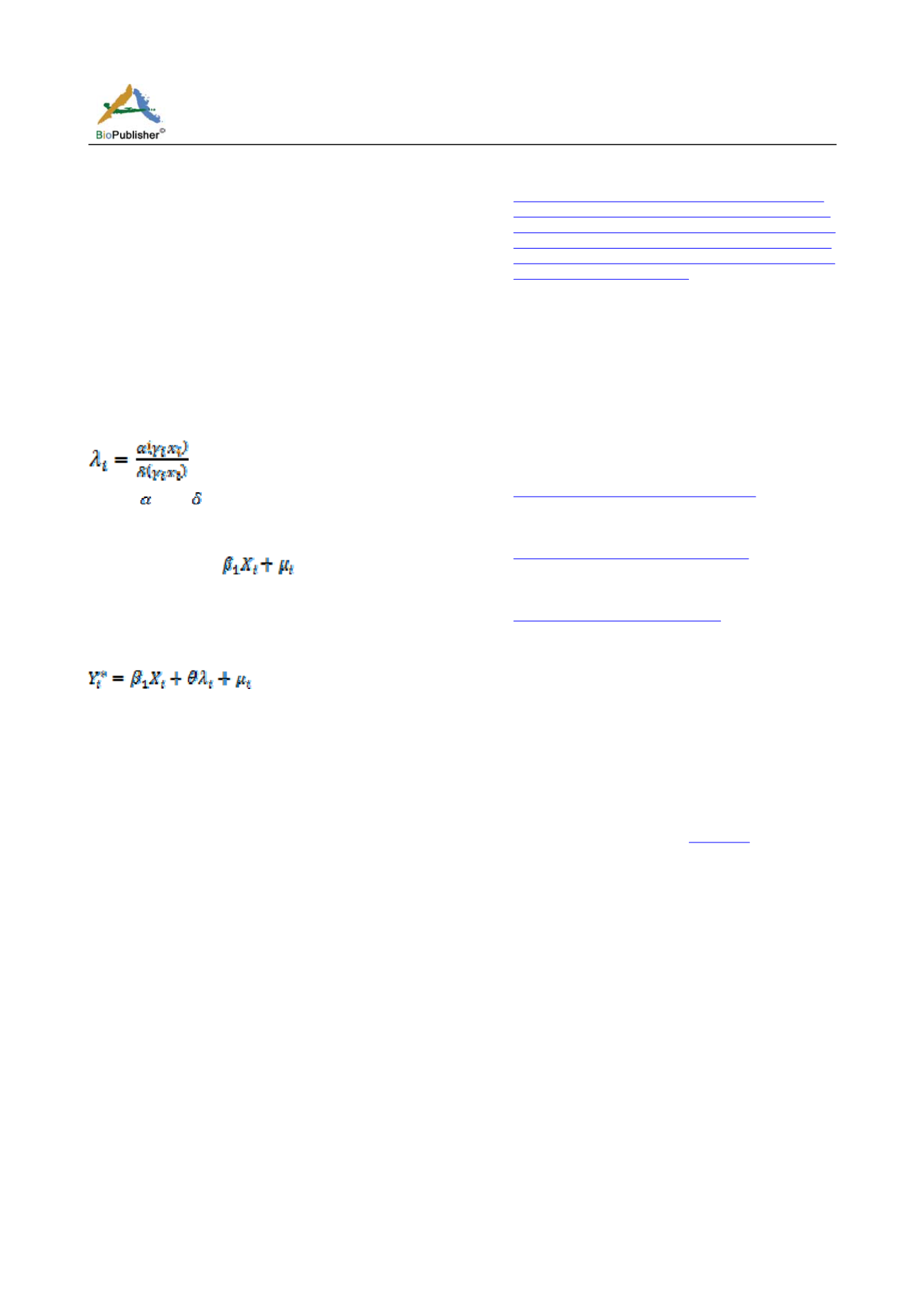
Rice Genomics and Genetics 2015, Vol.7, No.1, 1-10
9
X
11
=Access to improved rice seeds
X
12
=Agricultural training
X
13
=Off- farm employment
X
14
=Agricultural income
Equation (2) is estimated by maximum likelihood as
an independent probit model from the entire sample
of adopters and non-adopters; X is a vector of
factors influencing the decision to adopt. The sample
selection bias is what Heckman (1979) refers to as
the inverse Mill’s ratio (λ), is computed from the
parameter estimates of the selection equation for
each observation in the selected sample (Greene
1993), and is represented by:
(3)
Where and are respectively, the density and
distribution functions.
The level of adoption, Y
i
, specified in equation (4),
is observed only if
>0, and is estimated
by ordinary least squares, where the vector of
inverse Mill’s ratios is included as an additional
regressor in order to correct for potential selection
bias.
(4)
Y= proportion of area under improved rice variety.
The independent variables were as defined in the
selection model above.
Acknowledgement
Financial support by Africa Rice is gratefully acknowledged.
References
Adeogun O.A., Ajana A.M., Ayinla O.A., Yarhere M.T., and Adeogun
M.O., 2008, Application of logit model in adoption decision: A study
of hybrid clarias in Lagos, Nigeria, Journal of Agricultural &
Environmental Sciences, 4(4): 468-472
Africa Rice Center (WARDA), 2007, African Rice Trends: Overview of
Recent Development in the Sub-Saharan Africa Rice Sector. Africa
Rice Center Brief. Cotonou, Benin: WARDA. 8pp.
Africa Rice Center (WARDA)/FAO/SAA, 2008, NERICA: the New Rice
for Africa-a Compendium. EA Somado, RG Guei and SO Keya
(eds.). Cotonou, Benin: Africa Rice Center (WARDA); Rome, Italy:
FAO; Tokyo, Japan: Sasakawa Africa Association. pp. 210
African Rice Centre (WARDA), 2006, Progress Report 2003-2005. Joint
Interspecific Hybridization Project. WARDA, Cotonou, Bennin.
Akande S.O., 2002, An Overview of the Nigerian Rice Economy, NISER,
Ibadan.
Awotide B.A., Diagne A., Awoyemi T.T., and Ojehomon V.E.T., 2011,
Impact of Access to Subsidized Certified Improved Rice Seed on
Income: Evidence from Rice farming Households in Nigeria. OIDA
International Journal of Sustainable Development, 2(12): 43-60
Bwire Joseph, 2008, Factors affecting adoption of improved meat goat
(boer) production in Rangelands of Sembabule District. Unpublished
M.Sc thesis Makerere University Kampala.
Chuma Ezedinma, 2012, Impact of Trade on Domestic rice Production
and the Challenge of Self Sufficiency in Nigeria.
=
web&cd=1&cad=rja&ved=0CDYQFjAA&url=http%3A%2F%2Fw
ww.warda.cgiar.org%2Fworkshop%2Fricepolicy%2Fchuma.e%2Fch
uma.e.nigeria.paper.pdf&ei=DTIrUsegOoqX1AXz5IHgBQ&usg=A
FQjCNGyzxzZJgUioyAtII3qbJOzbAC70g&sig2=5_P16Z1TApHFY
31lskiG-A&bvm=bv.51773540,d.d2k
Accessed 7
th
sept., 2013.
Daramola B., 2005, Government Policies and Competitiveness of
Nigerian Rice Economy. A Paper presented at the `Workshop on
Rice Policy & Food Security in Sub-Saharan Africa’ organized by
WARDA, Cotonou, Republic of Benin, November, 07-09.
Diagne A., 2006, Taking a New Look at Empirical Models of Adoption:
Average Treatment Effect Estimation of Adoption Rates and their
Determination. Paper presented at the 26 conference of the
International Association of Agricultural Economics August 12-18,
at Gold Coast, Austria.
Diagne A., and Demont M., 2007, Taking a New Look at Empirical
Model of Adoption: Average Treatment Effect Estimation of
Adoption Rates and their Determinants. Agricultural Economics, 37:
201- 210
Dimara E., and Skurus D., 1998 Adoption of New Tobacco Varieties in
Greece: Impacts of Empirical Findings on Policy Design: Agricultural
Economics, 19: 297-307
Dow W., and Norton E., 2003, Choosing Between and Interpreting the
Heckit and Two- Part Models for Corner Solutions, Health Services
& Outcome Research Methodology, 4: 5-18
Erenstein O., Lançon F., Osiname O., and Kebbeh M., 2004, Operationalising the
strategic framework for rice sector revitalization in Nigeria. Project
report -The Nigerian Rice Economy in a Competitive World: Constraints,
Opportunities And Strategic Choices. Abidjan: WARDA-The Africa
Rice Centre. pp. 11-35.
Fagade S.O., 2000, Yield Gaps and Productivity Decline in Rice
Production in Nigeria. Paper Presented at the Expert Consultation on
Yield Gap and Production Decline in Rice, 5-7 September, 2000.
FAO, Rome, Italy. Pp.15
Falusi A.O., 1997, Agricultural Development and Food Production in
Nigeria: Problems and Prospects. In: B., Shaid, N.O., Adedipe, M.
Aliyu and Jir, M. (eds.) Integrated Agricultural Production in Nigeria:
Strategies and Mechanism (NARP Monograph No. 5. pp. 151-170
Food and Agricultural Organization 2002:
.
Heckman J., 1979, Sample Selection Bias as a Specification Error,
Econometrica, 47:1 (153- 161)
Jackline Bonabana-Wabbi, 2002, Assessing Factors Affecting Adoption of
Agricultural Technologies: The Case of Integrated Pest Management
(IPM) in Kumi District, Eastern Uganda. Unpublished M.Sc thesis
Virginia Polytechnic Institute and State University Blacksburg, Virginia.
Keuneman E.A., 2006, Improved rice production in a changing
environment: from concept to practice. Int. Rice Commission
Newslett. 5: p. 2
Nkang N.M., Abang S.O., Akpan O.E., and Offem K.J., 2006, Co
integration and Error Correction Modelling of Agricultural Export
Trade in Nigeria: The case of Cocoa. Journal of Agriculture and
Social Sciences.
Ogundele O.O., Ojehomon V.E.T., Momoh S., Ogunremi L.T., Tiamiyu
S.A., and Wayas J.W., 2004, Rice Policy and Cognate Economic
Issues. The Nigeria Rice Memorabilia Project Synergy Limited,
Abuja, Nigeria xxxvi 1145 pages. Pg.7
Oyekale A.S., and Idjesa E., 2009, Adoption of improve maize seed and
the efficiency in River State, Nigeria, Academic Journal of Plant
Sciences, 2(1): 44-50
PCU2001, Terms of reference: social and beneficiary impact assessment.
Sheda: Project Coordinating Unit.


